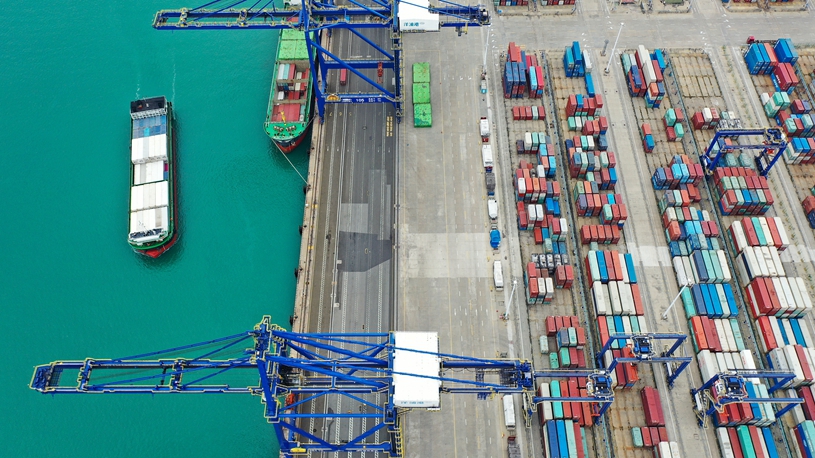* China launched a new relay satellite on Wednesday to provide Earth-Moon communications services, a key step for its future lunar exploration missions such as retrieving samples from the far side of the moon and exploring the lunar south pole region.
* The name of the satellite, Queqiao, embodies China's hope that the relay satellite could serve as a vital communication link between Earth-based controllers and the mysterious far side of the moon.
* The deployment of the Queqiao-2 relay satellite is a key step for China's future lunar exploration missions including Chang'e-6, Chang'e-7 and Chang'e-8.
WENCHANG, Hainan, March 20 (Xinhua) -- China launched a new relay satellite on Wednesday to provide Earth-Moon communications services, a key step for its future lunar exploration missions such as retrieving samples from the far side of the moon and exploring the lunar south pole region.
A Long March-8 rocket, carrying the satellite dubbed Queqiao-2, or magpie bridge-2, soared into the sky at 8:31 a.m. from the Wenchang Space Launch Site in south China's Hainan Province.
After 24 minutes of flight, the satellite separated from the rocket, and entered the planned Earth-Moon transfer orbit with the perigee at 200 kilometers and the apogee at 420,000 kilometers. The satellite's solar panels and communications antennae were unfolded, according to the China National Space Administration (CNSA).
"Today's launch has laid a good foundation for the ensuing flight control of the Queqiao-2 relay satellite," said Ge Ping, deputy director of the CNSA's Lunar Exploration and Space Program Center.
However, the successful launch is only the first step of the Queqiao-2 mission. A series of important maneuvers such as midway trajectory correction, decelerating near the moon and orbit adjustment will be carried out before Queqiao-2 enters its target elliptical orbit around the moon to become the world's second relay satellite deployed beyond Earth orbit.
After that, communications tests will be carried out to determine whether the Queqiao-2 relay satellite has the ability to support the sample collection mission from the far side of the moon, Ge said.
NEW BRIDGE OF COMMUNICATIONS
According to a Chinese folktale, Zhi Nyu, the seventh daughter of the Goddess of Heaven, and her beloved husband, Niu Lang, a humble cowherd, found their love forbidden and were separated to opposite sides of the Milky Way. Moved by their plight, magpies intervened, creating the Queqiao bridge with their wings on the seventh night of the seventh month of the lunar calendar, allowing the couple to reunite for just one day each year.
Hence, the name of the satellite, Queqiao, embodies China's hope that the relay satellite could serve as a vital communication link between Earth-based controllers and the mysterious far side of the moon.
Since the moon's revolution cycle is the same as its rotation cycle, the same side always faces Earth. The other face, most of which cannot be seen from Earth, is called the far side or "dark side" of the moon. This term doesn't refer to darkness but rather to the mystery shrouding the moon's largely unexplored terrain.
Due to its special environment and complex geological history, the far side of the moon stands as a prime destination for scientific and space exploration. In order to explore the moon's far side, China sent the first Queqiao relay satellite in 2018 to a halo orbit around the second Lagrangian (L2) point of the Earth-Moon system.
Thanks to the communications support and data transmission from this relay satellite, China later successfully sent the Chang'e-4 probe to the Von Karman Crater in the South Pole-Aitken Basin, realizing the first-ever soft landing and roving on the far side of the moon at the beginning of 2019.
Since the first Queqiao satellite has exceeded its designed lifespan, Queqiao-2 will take over the communications relay services for Chang'e-4, which is still operating on the moon's far side.
Compared with the first Queqiao satellite, the new satellite launched on Wednesday boasts enhanced functionality, innovative features and intricate designs. It also carries multiple instruments for scientific exploration, the CNSA said.
KEY STEP FOR FUTURE MOON MISSIONS
The deployment of the Queqiao-2 relay satellite is a key step for China's future lunar exploration missions including Chang'e-6, Chang'e-7 and Chang'e-8.
The landing and sample collection sites of China's moon missions in the coming years are mainly in the lunar south pole region or on the far side of the moon. A more powerful relay satellite with more functions is necessary to provide communications and data transmission services for the missions, the CNSA said.
Chang'e-6 is scheduled for launch in the first half of 2024, while Chang'e-7 will be launched around 2026, and Chang'e-8 around 2028. Chang'e-7 and Chang'e-8 will form the basic model of a lunar research station to carry out lunar environment exploration, according to the CNSA.
In addition to China's missions, the Queqiao-2 relay satellite can also provide communications services for other country's lunar exploration missions, the CNSA said.
"China has always attached great importance to international cooperation in the lunar exploration program. And many win-win results have been achieved in the previous lunar missions," Ge said.
China has initiated the application process for researchers worldwide to study the lunar samples gathered by the Chang'e-5 mission, and also welcomes other countries to cooperate in China's future lunar and planetary exploration projects, Ge said.
Together with Queqiao-2, two communications and navigation technology test satellites Tiandu-1 and Tiandu-2 were also sent into space by the Long March-8 carrier rocket. With a total length of 50.3 meters, the rocket has two stages and two liquid boosters. This is the first time a Long March-8 carrier rocket has been used for a lunar exploration mission.
"We have improved and optimized the design of the rocket for the mission to enhance its reliability," said Xu Shanshu, a chief designer for the rocket, from the China Academy of Launch Vehicle Technology under the China Aerospace Science and Technology Corporation.
Wednesday's launch was the 512th mission of the Long March rocket series.
(Video reporters: Zhao Yuhe, Li Duojiang, Mei Yuanlong; Video editors: Li Ziwei, Hui Peipei) ■











